Table of Contents
A strong pair of round and wide shoulders is the crown jewel of well-built arms. Shoulders create the top frame of your upper body giving it that upside-down triangle shape, which is precisely what every bodybuilder and fitness athlete wants. Not only does a powerful shoulder physique make the body look overall more athletic, it also contrasts beautifully with a thin waist, which is a look especially women tend to strive for. However, when working on your shoulders, it’s not quite enough to place all of your bets on a simple military press, or dumbbell shoulder press. A good shoulder workout focuses on a comprehensive activation of their entire range.
How to train your shoulders?
Shoulder muscles (Musculus Deltoideus), also known as deltoid muscles, are composed of anterior deltoid, medial/lateral deltoid and posterior deltoid. Their main function is to stabilize the shoulder joint, and to allow the abduction of the shoulder. In other words, they help you raise your arms up. Having strong delts is important not only for sports (throwing or lifting overhead), as well as in daily life. You use them whenever you reach up to the upper shelf to grab your protein powder, or when you decide it’s time to put a new coat of paint on your home’s walls. [1]
When working on your shoulders, the same rules apply as when working on any other muscle group. Always make sure that you’ve warmed up properly to prepare your muscles for the strain, and to avoid needless injury. A good way to start is by doing some shoulder rotations in both directions. Follow by performing the first reps of your routine with lighter weights. Once you get to it, focus on mastering the proper technique of the exercise and only then take the step towards heavier dumbbells.
The exercises presented in this article will help you build a gym training routine for your shoulders. To begin, simply pick two to three of these exercises, and perform three sets within the 8 to 12 rep range. The overall load should correspond to about 60 to 75% of your 1RM (the maximum amount of weight that you can possibly lift for one rep). Your shoulder routine can be done on its own, or combined with other muscle group workout such as your back, ideally two to three times a week. Keep in mind that full regeneration of any muscle group typically takes up between 24 and 72 hours. Considering this, always take the regeneration period into account when planning out your weekly training routine and rep ranges for each specific muscle group that you are working on. [2–4]

9 most effective exercises for your shoulders
There is no shortage of shoulder exercises out there. In today’s article, we will present the most effective ones there are. To perform these, you will only need the regular equipment widely available in every gym such as an adjustable bench, an Olympic barbell with weight plates, dumbbells or basic gym pulley machines. Which of these you ultimately choose to incorporate into your training routines is all up to you. Some exercises offer alternatives and modifications.
With each one of these exercises, always keep in mind to activate your shoulder muscles and core. This will help you maintain proper technique and posture.
1. Dumbbell Lateral Raise
- Starting position: Stand with your feet hip-width apart and grab a dumbbell in each hand. Straighten up and bend your knees slightly. Pull your shoulders away from your ears and bring your shoulder blades together. Bend your arms slightly at the elbows as they extend along your body, and point your palms towards your sides.
- Execution: Raise your arms sideways in a controlled movement while exhaling and keeping your elbows slightly bent. Try to raise the dumbbells all the way to the level of your shoulders, or slightly above. Once you reach the upper position, you may try to hold it for a second. Then slowly return to the starting position with an inhale and follow with a next repetition.
- Common mistakes: Raised shoulders, uncontrolled (jerking) movement, inappropriate load, a small range of motion.
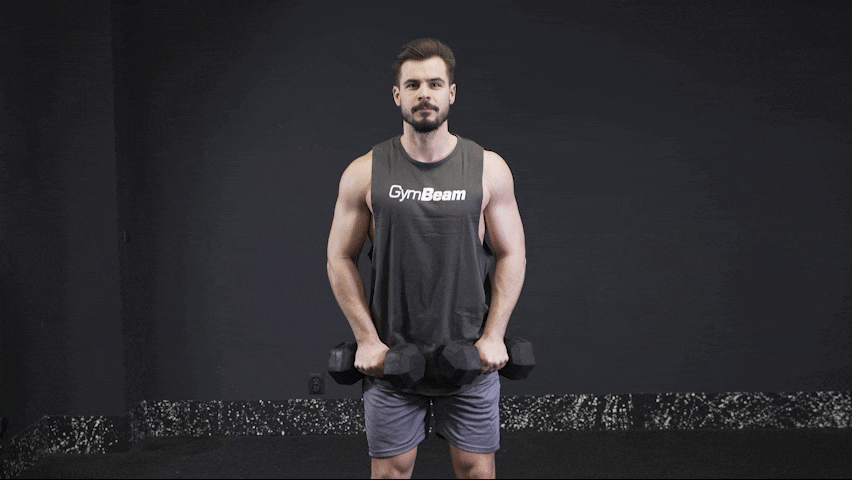
Further variations of the exercise:
1. Arm Standing Dumbbell Lateral Raise
Alternatively, you can perform a set with each arm separately. This way, you’ll be able to better focus on executing the exercise with a proper technique.
2. Dumbbell Front Raise
- Starting position: Stand with your feet hip-width apart and grab a dumbbell in each hand using an overhand grip in front of your thighs. Straighten up and bend your knees slightly. Pull your shoulders away from your ears and bring your shoulder blades together. Bend your arms slightly at the elbows as they extend along your body, and point your palms towards your sides.
- Execution: Raise your arms in front of you in a controlled movement while exhaling and keeping your elbows slightly bent. Try to raise the dumbbells all the way to the level of your shoulders, or slightly above. Once you reach the upper position, you may try to hold it for a second. Then slowly return to the starting position with an inhale and follow with a next repetition.
- Common mistakes: Raised shoulders, uncontrolled (jerking) movement, inappropriate load, a small range of motion.
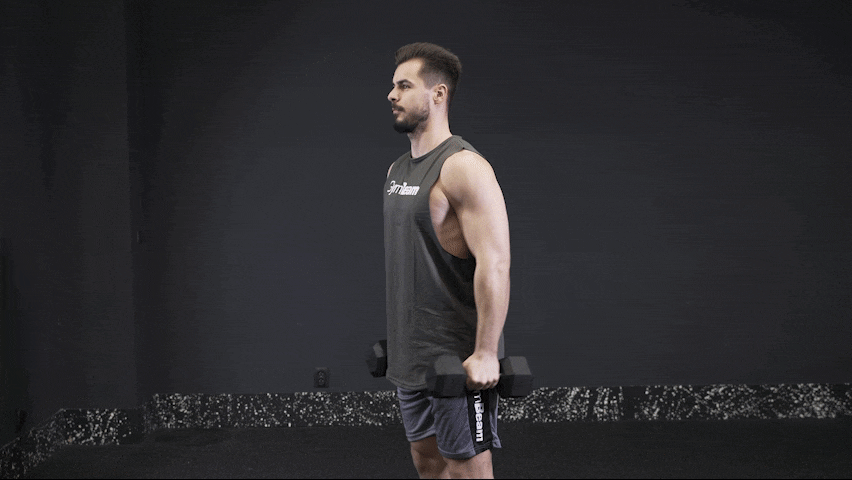
Further variations of the exercise:
1. Single Arm Dumbbell Front Raise
This variation can also be performed with each arm separately. This way, you’ll be able to better focus on executing the exercise with a proper technique.
You might be interested in these products:
3. Arnold Dumbbell Press
- Starting position: Sit on an exercise bench with your back straight, bend your knees and place your feet firmly on a mat. Grab a dumbbell with each hand and raise them to shoulder height in front of your chest, palms facing towards you. Try to keep your wrists straight. Pull your shoulders away from your ears and pull your shoulder blades together.
- Execution: With an exhale, raise your arms overhead in a controlled motion. As your hands go up, rotate them smoothly so that in the upper position, your palms are facing away from your body, straight in front of you. Then slowly return to the initial position with an inhale and follow with the next repetition.
- Common mistakes: Raised shoulders, bent wrists, uncontrolled (jerking) movement, inappropriate load.
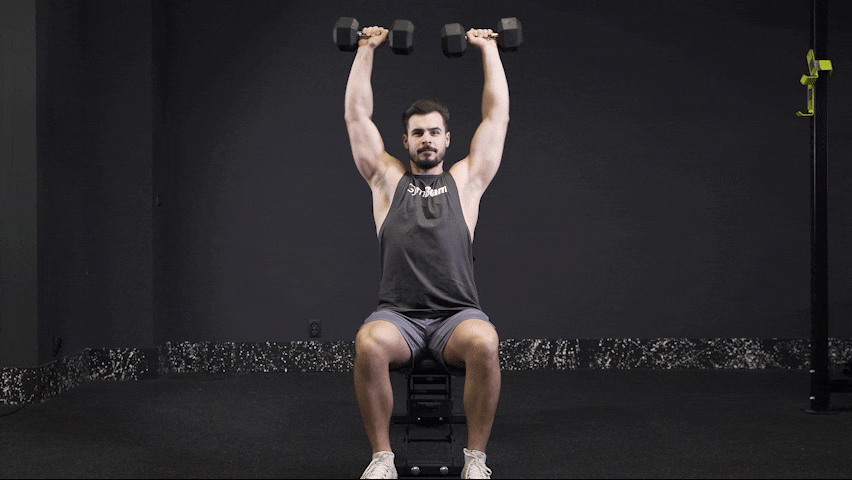
Further variations of the exercise:
1. Single Arm Arnold Dumbbell Press
Alternatively, you can perform a set with each arm separately. This way, you’ll be able to better focus on executing the exercise with a proper technique.
2. Arnold Kettlebell Press
This exercise can also be performed using a pair of kettlebells. Simply grasp each kettlebell by the handle in its upper section and follow the same way you would with a pair of dumbbells.
4. Seated Dumbbell Press
- Starting position: Sit on an exercise bench with your back straight, bend your knees and place your feet firmly on a mat. Grab a dumbbell with each hand and raise them to shoulder height by your sides, palms facing in front of you. Keep your wrists straight. Pull your shoulders away from your ears and pull your shoulder blades together.
- Execution: Breathe in and raise your arms overhead until your elbows are straight up. Palms face forward throughout the entire motion. Then slowly return to the initial position with an inhale and follow with the next repetition.
- Common mistakes: Raised shoulders, bent wrists, uncontrolled movement, insufficient range of motion, inappropriate load.
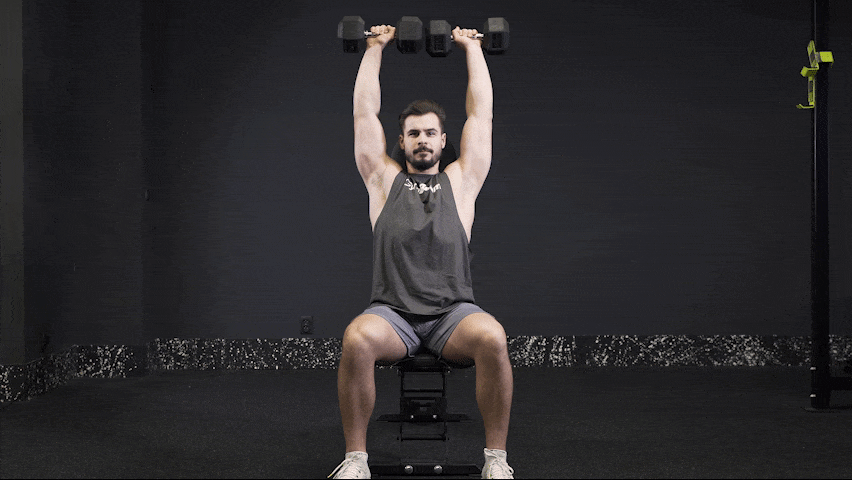
Further variations of the exercise:
1. Single Arm Seated Dumbbell Press
You can also do this exercise alternating arms within a set, or exercising only one arm at a time.
2. Seated Kettlebell Press
This exercise can also be done using a pair of kettlebells. Simply grasp them by the handle in the upper section and use them the same way you would use dumbbells. If you only have a single kettlebell, you can exercise one arm at a time.
5. Seated Barbell Press
- Starting position: Sit on an exercise bench with your back straight, bend your knees and place your feet firmly on a mat. Grasp a barbell with an overhand grip and raise it underneath your chin, so that it rests in front of the upper section of your chest. Keep your wrists straight. Pull your shoulders away from your ears and pull your shoulder blades together.
- Execution: With an outbreath, raise your arms overhead in a controlled movement. Then, inhaling, return to the initial position in a smooth motion. Follow with the next repetition.
- Common mistakes: Raised shoulders, bent wrists, uncontrolled movement, bending the lower back, a small range of motion, inappropriate load.
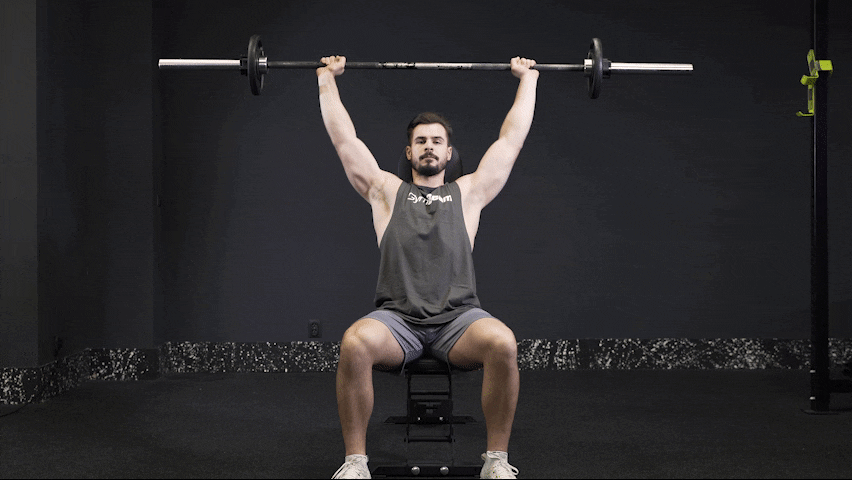
6. Standing Barbell Press
- Starting position: Stand with your feet hip-width apart and grasp a barbell with both hands, using an overhand grip. Straighten up and bend your knees slightly. Lift the barbell up to just underneath your chin, so that it rests in front of your upper chest. Keep your wrists straight. Pull your shoulders away from your ears and pull your shoulder blades together.
- Execution: With an outbreath, raise your arms overhead in a controlled movement. Then, inhaling, return to the initial position in a smooth motion. Follow with the next repetition.
- Common mistakes: Raised shoulders, bent wrists, uncontrolled (jerking) movement, inappropriate load.

7. Bus Driver
- Starting position: Stand with your feet hip-width apart and grab a weight plate with both hands by its sides. Straighten up with your knees slightly bent and hold the disc in front of your thighs with your arms outstretched. Pull your shoulders away from your ears and pull your shoulder blades together.
- Execution: With an outbreath, raise your arms in front of you in a controlled motion and simultaneously rotate the weight plate clockwise until one hand reaches a position directly above the other. Then return to the initial position and repeat the same movement, this time rotating the plate counter-clockwise.
- Common mistakes: Raised shoulders, uncontrolled (jerking) movement, inappropriate load.
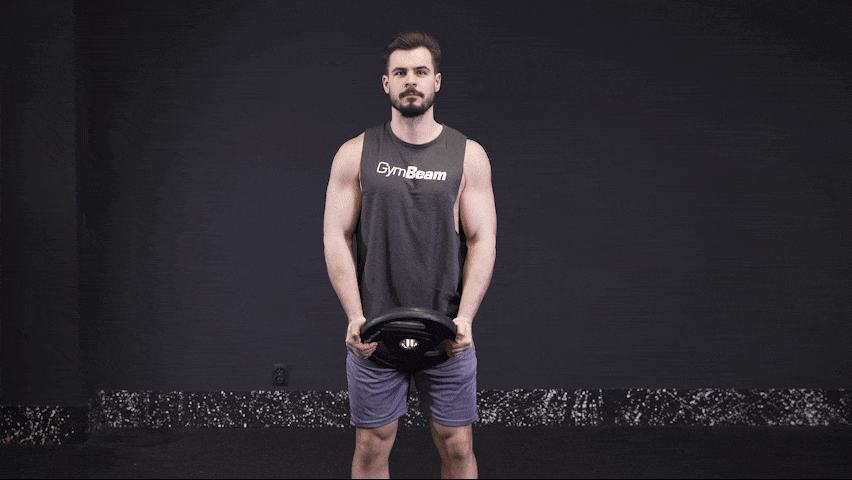
Further variations of the exercise:
1. Dumbbell Bus Driver
To do this exercise, you can use a dumbbell too. Grab it by the sides, with your fingers around the weight sections. Execute the same way you would be holding a weight plate.
2. Holding the Bus Driver (Plate Front Raise With Rotation)
You can perform another variation of this exercise by simply holding the weight plate in front of you the entire time, rotating it side to side without dropping your arms in between the rotations.
8. Single Arm Cable Lateral Raise
- Starting position: Stand with your feet hip-width apart to the side of a pulley machine. Grasp a single handle connected to the lowest position of the pulley with the hand further away from the pulley. Straighten up and hold the handle with a slightly bent arm at the level of your upper thigh. You may put your other hand on your hip.
- Execution: With an outbreath, raise your arm sideways in a controlled motion, keeping the elbow slightly bent. You may hold the upper position for one to two seconds. Then return smoothly into the initial position and follow with the next repetition. Once you finish a set, switch sides and do the exercise with the other arm.
- Common mistakes: Raised shoulders, uncontrolled (jerking) movement, inappropriate load.

9. Face Pulls
- Starting position: Stand with your feet hip-width apart, facing a pulley machine. Grab the ends of the rope attachment attached to the upper position of the pulley with both hands. Straighten up and raise your arms in front of you, with your elbows slightly bent.
- Execution: With an outbreath, pull the rope towards your forehead in a controlled motion. In addition to the shoulders, also focus on engaging the interscapular muscles. Once you’ve pulled the adapter to your face, you may hold this position for one or two seconds. Then return smoothly into the initial position and follow with the next repetition.
- Common mistakes: Raised shoulders, uncontrolled movement, inappropriate load.
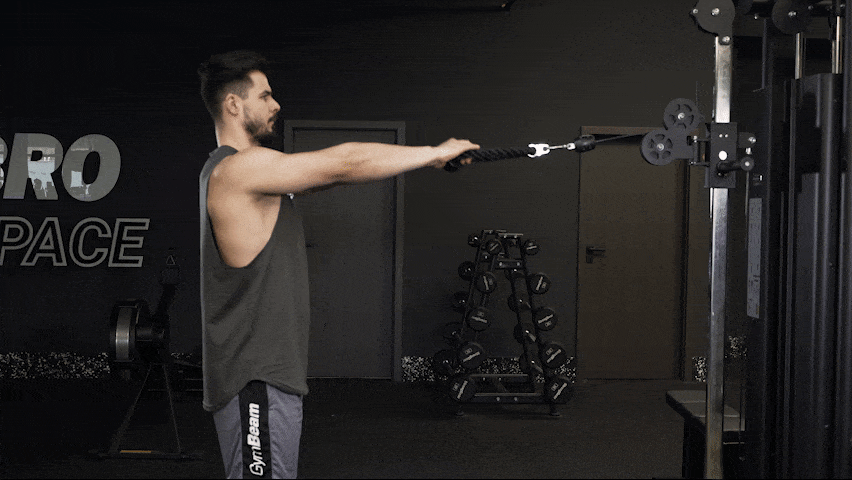
How to effectively exercise your shoulders?
To learn more about what to watch out for when exercising your shoulders, watch our video.
What’s next?
- Do you want to learn how to set up an adequate training plan for yourself? Find out about it in our article How to Create a Quality Gym Workout Plan?
- Learn how to set the proper resistance level to your exercises in our article How Much Weight to Lift for Muscle Growth, Strength or Weight Loss?
- If you’re looking for some effective exercise tips for working on your back, check out our 9 Best Exercises for Your Back.
- To make sure your upper body workout is appropriately comprehensive, don’t forget about your biceps and triceps. To get inspired, read about the 8 Best Biceps Exercises and to include your triceps too, don’t miss out on our list of 10 Best Triceps Exercises.
- If your goal is to gain muscle mass, don’t miss out on our article What to Eat and How to Exercise to Finally Gain Muscle?
- Trying to grow some muscle, but nothing’s happening? Don’t miss out on our article 10 Tips for Healthy Weight Gain.
- Want to calculate your ideal calorie and macronutrient intake following your goals? Take advantage of our Online Energy and Macronutrient Intake Calculator.
What should you remember?
If you invest enough of your training time into working on your shoulders, you can look forward to seeing bigger, stronger and more toned deltoid muscles. After a while, you’ll also notice widening of the chest, which will optically narrow down your waist. When making your training plan, don’t forget to include barbell press, lateral raises with dumbbells or a variety of shoulder exercises on a pulley machine. Incorporating a range of modifications will ensure that your training engages all three parts of your deltoids. Always pay attention to your technique and feeling your muscles engage the right way, and add the load slowly and steadily. Make these shoulder exercises part of your workout routine two to three times a week. When planning this, keep in mind that your body needs proper time for recovery.
Did you find this article helpful? If so, share it with your friends and help them get inspired in their shoulder training routine too.
[1] Deltoid. Physiopedia. – https://www.physio-pedia.com/Deltoid
[2] Burd, N. A., West, D. W. D., Moore, D. R., Atherton, P. J., Staples, A. W., Prior, T., Tang, J. E., Rennie, M. J., Baker, S. K., & Phillips, S. M. . Enhanced Amino Acid Sensitivity of Myofibrillar Protein Synthesis Persists for up to 24 h after Resistance Exercise in Young Men. – https://doi.org/10.3945/jn.110.135038
[3] Krzysztofik, M., Wil k, M., Wojdała, G., & Gołaś, A. Maximizing Muscle Hypertrophy: A Systematic Review of Advanced Resistance Training Techniques and Methods.– https://doi.org/10.3390/ijerph16244897
[4] Schoenfeld, B. J., Grgic, J., Van Every, D. W., & Plotkin, D. L. Loading Recommendations for Muscle Strength, Hypertrophy, and Local Endurance: A Re-Examination of the Repetition Continuum.– https://doi.org/10.3390/sports9020032


Add a comment